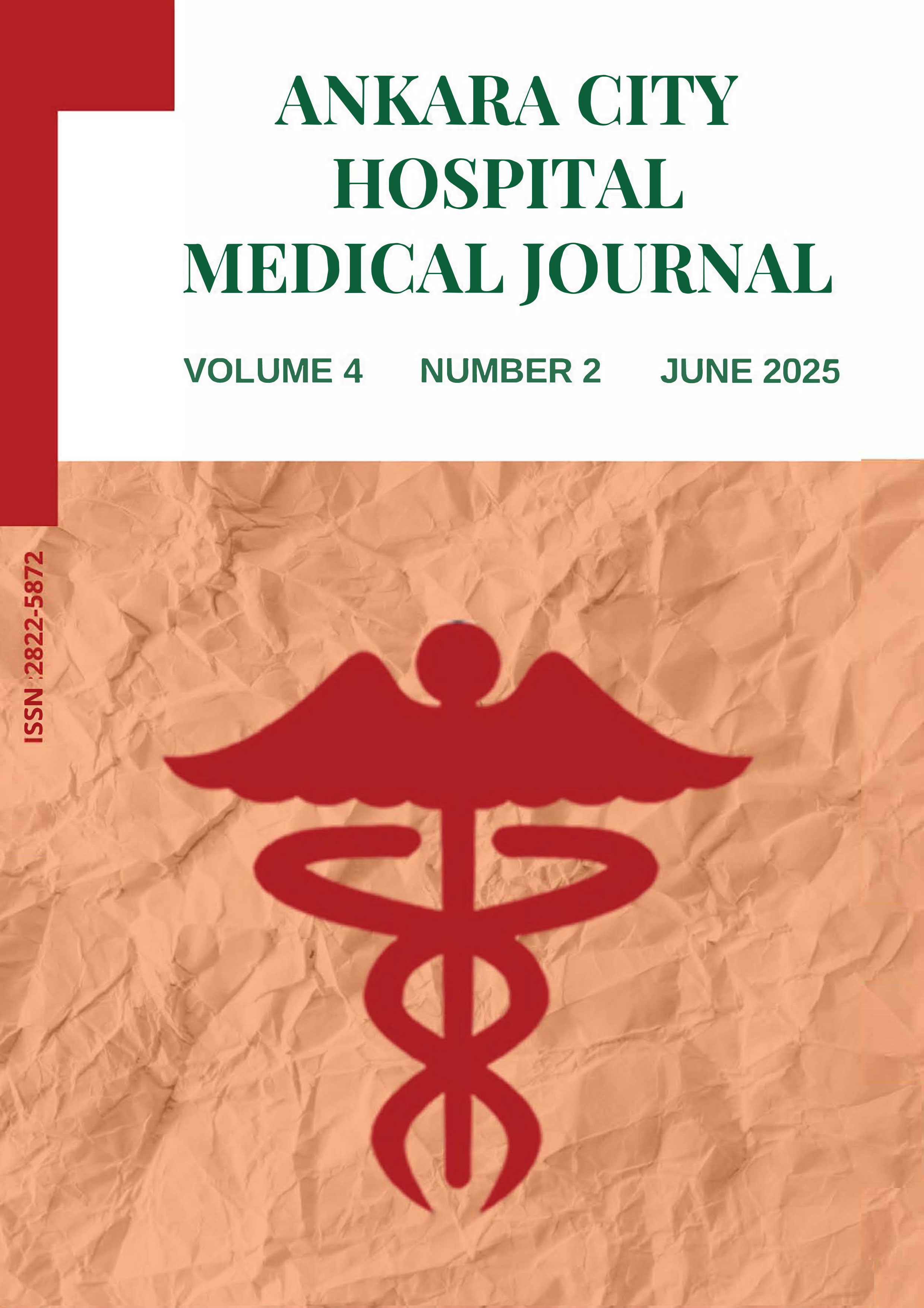
Volume: 3 Issue: 4 - December 2024
| 1. | Full Issue Pages I - II |
| RESEARCH ARTICLE | |
| 2. | Chemoradiotherapy Results Without Surgery in Patients with Locally Advanced Esophageal Squamous Cell Carcinoma Çağkan Ergiden, Ipek Pinar Aral, Gonca Altınışık İnan, Sedef Gökhan Açıkgöz, Hamza Onur Sarpkaya, Havva Beyaz, Hüseyin Furkan Öztürk, Suheyla Aytac Arslan, Muhammed Bulent Akinci, Yilmaz Tezcan doi: 10.5505/achmedj.2024.03521 Pages 123 - 130 INTRODUCTION: It aimed to evaluate the overall survival (OS) results of chemoradiotherapy (CRT) without surgery in patients with locally advanced esophageal squamous cell carcinoma (ESCC). METHODS: Patients who received chemoradiotherapy with a diagnosis of ESCC at the Radiation Oncology Department of Ankara Bilkent City Hospitals were retrospectively analysed. The primary endpoint was OS. RESULTS: The results of 46 patients who underwent radiotherapy (RT) between 26.06.2012 and 21.03.2023 were analysed. Median follow-up was 14 (range 1-47) months. The localisation was upper thoracic in 8(17.4%), middle thoracic in 36(78.3%) and lower thoracic in 2(4.3%) patients. Surgery was considered at the time of admission to the radiotherapy clinic in 25 (54.3%) of our patient group, and neoadjuvant treatment was given, but no surgery was subsequently performed. Patients referred to the radiotherapy clinic for neoadjuvant chemoradiotherapy received a significantly lower total dose than those referred directly for definitive chemoradiotherapy (p0.006; Z-2.768). Patients were evaluated by endoscopic biopsy and computed tomography 6-8 weeks after the end of treatment, and clinical complete response (cCR) was observed in 15 (32.6%) patients. At last follow-up, 19 (41.3%) patients were dead and 27 (58.7%) were alive. Median OS was 25 months (range 1.5-47). 1-year OS was 66%; 2-year OS was 54.7%; 3-year OS was 40.4%. Significantly higher OS was observed in patients with cCR (HR 4.2; 95% CI 1.2-14.7). DISCUSSION AND CONCLUSION: Patients referred to the radiotherapy clinic for neoadjuvant therapy received a significantly lower total dose than patients referred for definitive chemoradiotherapy. Patients who received cCR after chemoradiotherapy had significantly higher OS. |
| 3. | Fetal Humerus Length Nomogram in Gestational Weeks 19-24: Clinical Significance, Gender and Turkish Ethnical Differences Ayşe Ceren Duymuş, Nizamettin Bozbay, Gokcen Orgul doi: 10.5505/achmedj.2024.96967 Pages 131 - 136 INTRODUCTION: Objective To create a comprehensive fetal humerus length nomogram that is both gender- and ethnically relevant and applicable to the specified gestational weeks. METHODS: We conducted a retrospective cohort study that included singleton pregnancies between 19 and 24 weeks of gestation who were admitted to our clinic between 2021 and 2023. The study population comprised pregnant women who identified themselves as originating from the primary Turkish ethnic group and are between the age of 18 to 45. Ultrasonographic measurements were conducted by a single clinician using a General Electric Voluson E6 (USA) ultrasonography device with a transabdominal approach. Biometric evaluation of fetus was determined with measurements taken for Biparietal Diameter, Head circumference, Abdominal Circumference, Femur Lenght and Humerus Lenght. RESULTS: Gender-specific nomograms were constructed according to the gestational weeks. No significant differences were observed between the fetal genders,however, the humerus length of the fetuses was found to be greater than that documented in other populations, as evidenced in the WHO fetal growth charts. DISCUSSION AND CONCLUSION: The findings of our study demonstrate the necessity of ethnic-specific fetal HL nomograms. Furthermore, we anticipate that our results will contribute to the development of customised fetal nomograms for the Turkish population, in the future. In conclusion, by using a nomogram that accounts for ethnic differences, clinicians can better identify at-risk populations and provide targeted interventions, ultimately improving fetal outcomes. |
| 4. | Is plasminogen activator inhibitor-1 level a prognostic marker in COVID-19? Güler İnönü, Oguzhan Zengin, Esra Fırat Oğuz, Enes seyda Şahiner, İhsan Ateş doi: 10.5505/achmedj.2024.38233 Pages 137 - 145 INTRODUCTION: We aimed to investigate the relationship of plasminogen activator inhibitor-1 (PAI-1) level, which is the main inhibitor of the fibrinolytic system, with COVID – 19 severities. METHODS: A total of 88 cases diagnosed with COVID – 19, 42 with mild pneumonia and 46 with severe pneumonia, were prospectively included in the study. Serum PAI-1 level was studied by ELISA method. COVID – 19 diagnosis was made by reverse transcriptase-polymerase chain reaction test. RESULTS: PAI – 1 level was found to be higher in the group with severe pneumonia compared to the group with mild pneumonia (72.1 ng/mL vs 64.1 ng/mL, respectively; p=0.005). In the multivariate regression analysis high level of serum PAI – 1 was associated with severe pneumoniae (OR: 1.073; CI: 1.003 – 1.147; p=0.040). The cut off value of PAI – 1 for severe pneumoniae was determined as 65.8 ng/mL with 52.2% sensitivity, specificity of 78.6%, positive predictive value of 72.7% and negative predictive value of 60%. The patients whose PAI – 1 level were over 65.8 ng/mL were found to have 4.646 times increased risk of severe pneumoniae compared to the ones who had PAI – 1 lower than 65.8 ng/mL (OR: 4.646; CI: 1.186 – 18.202; p= 0.027). DISCUSSION AND CONCLUSION: In this study, we found out that the serum level of PAI – 1 was higher in patients with severe pneumoniae than the ones with mild pneumoniae. High level of serum PAI – 1 was associated with severe pneumoniae. |
| 5. | The Evaluation Of Dysmenorrhea, Quality Of Life, And Sexual Functions In Patients With And Without Conization Belma Gözde Özdemir, Ahmet Bilgi, Kübra Sevinç, Aslı Mavi, Mehmet Kulhan, Çetin Çelik doi: 10.5505/achmedj.2024.07279 Pages 146 - 151 INTRODUCTION: Conization is a surgical procedure performed to treat precancerous lesions. HPV is the most predisposing cause known. In our study, we aimed to evaluate and compare patients who were followed up as HPV positive and had conization due to cervical pathology in terms of dysmenorrhea, quality of life and sexual function. METHODS: HPV positive patients who underwent conization at Selcuk University Faculty of Medicine Obstetrics and Gynecology Department were evaluated. 4 main surveys were used in the study. Personal and Demographic Information Form, Dysmenorrhea Scale - Visual Analogue Scale (VAS), Female Sexual Function Index (FSFI); It was evaluated using (Turkish Female Sexual Function Scale), and European Organisation for Research and Treatment of Cancer Quality of Life (Turkish EORTC QLQ-C30 (version 3.0)). In our study, we considered two groups: those without hpv positive conization and those with hpv positive conization. RESULTS: Dysmenorrhea scores of patients who underwent conization are higher than those of patients who did not undergo conization. Female sexual function scores of patients who underwent conization are higher than those of patients who did not undergo conization. There was no significant difference between the QoL scores of patients who underwent conization and those who did not. DISCUSSION AND CONCLUSION: The cervix has an anatomically important neurovascular network. Care should be taken at this point in terms of conization procedures. Surgical complications should be carefully evaluated in the treatment of precancerous lesions. HPV is a sexually transmitted disease and the treatment of lesions caused by it can affect anxiety, quality of life, sexual function and menstrual cyclus. |
| 6. | Definitive Radiotherapy/Chemoradiotherapy Results in Geriatric Non-Small Cell Lung Cancer Patients with Multiple Comorbidity Yasin Caygın, İpek Pınar Aral, Gonca Altınışık İnan, Muhammed Yılmaz, Çağkan Ergiden, Muhammed Bülent Akıncı, Yılmaz Tezcan doi: 10.5505/achmedj.2024.83997 Pages 152 - 160 INTRODUCTION: It was aimed to evaluate the definitive radiotherapy (RT)/chemoradiotherapy outcomes in geriatric non-small cell lung cancer (NSCLC) patients with multiple comorbidities. METHODS: Patients who received RT 06.03.2019 and 24.10.2022 in XXX Hospital were analyzed retrospectively. The primary endpoints were RT interruption, acute adverse events (AAE), complete of treatment. The secondary endpoints were overall survival (OS), disease-free survival (DFS). RESULTS: The results of 62 patients who received definitive RT/CRT were analyzed. Median follow-up time was 16 (2-55) months. The median age of the patients was 75(70-89) years. The median number of comorbidities was 3(2-6). Thirty-seven (59.7%) patients received concurrent chemotherapy (CRT);12(19.4%) patients received induction chemotherapy. One patient (1.6%) could not complete the RT and RT was interrupted in 6 (9.7%) patients. RT interruption was more common in patients with cerebrovascular disease (CVD) (p=0.002; OR5.5; CI %954,3-7). AAE were noted in 20 (32.3%) patients and AAEs increased with CRT (p=0.006; OR 6.2;95%CI1.5-24.4). Eighteen (29%) patients relapsed, 11(17.7%) of relapses were locoregional while 7 (11.3%) were distant. Median DFS was 12 (range1-50) months. Significantly higher DFS was observed in patients with squamous cell cancer (SCC) (p=0.021; HR 2.8;95%CI1.12-7.18). Thirty-three (53.2%) patients have died. Twenty-seven (81.8%) patients died without relapse, 6(17.2%) died after relapse. Median OS was 14 (2-50) months. Patients who interrupted RT had lower OS (p=0.003; HR5.96;95%CI2.23-15.9). Patients with 3≥ comorbidities had lower OS (14 vs10 months) (p=0.053; HR2.3;CI95%0.98-5.8). DISCUSSION AND CONCLUSION: Definitive RT/CRT is an effective treatment with acceptable toxicity in geriatric NSCLC patients with multiple comorbidities. |
| 7. | The Relationship Between Sleep and Quality of Life in Older People Living in Nursing Homes Fatmagül Gürsoy, Kamile Silay doi: 10.5505/achmedj.2024.28190 Pages 161 - 166 INTRODUCTION: Sleep problems are more prevalent in older adults compared to the general population. This study aims to assess the relationship between sleep quality, sleep propensity and quality of life among nursing home residents METHODS: A total of 107 nursing home residents who attended the geriatric outpatient clinic between May and July 2016 were included in the study. Demographic data and comorbidities were recorded. Sleep quality and sleepiness were evaluated using the Pittsburgh Sleep Quality Index (PSQI) and Stanford Sleepiness Scale (SSS), with higher scores indicating worse sleep quality and increased sleep propensity. Quality of life was measured using the SF-36 Quality of Life Scale. Statistical analyses were conducted using the Statistical Package for Social Sciences (SPSS) for Windows 21. Correlation analysis was performed using Spearman’s rho, with statistical significance set at p < 0.05. RESULTS: Among the 107 participants, 67 (62.6%) were women. The mean score of PSQI in the study population was found to be 6.33 ± 4.03. Of the participants, 65.3% were classified as having poor sleep quality. A positive and statistically significant correlation was observed between PSQI scores and all sub-dimensions of the SF-36 scale except pain. The correlation between the SSS and each sub-dimension of the SF-36 scale is statistically significant except pain and mental health status. DISCUSSION AND CONCLUSION: Our study demonstrates that poor sleep quality and daytime sleepiness are common among nursing home residents and are associated with lower quality of life. Dementia was identified as the most common comorbidity related to sleep problems. To improve the quality of life in nursing home residents, addressing sleep disturbances should be a key focus of care. |










